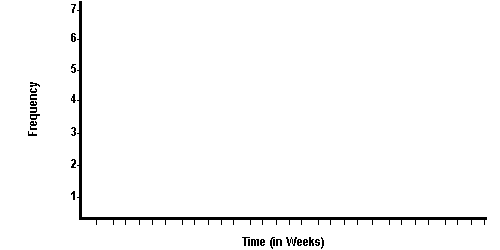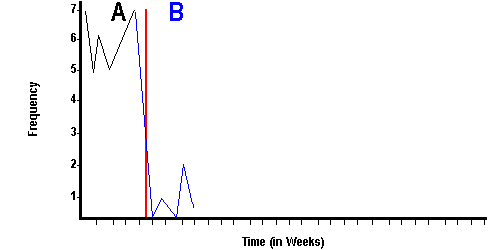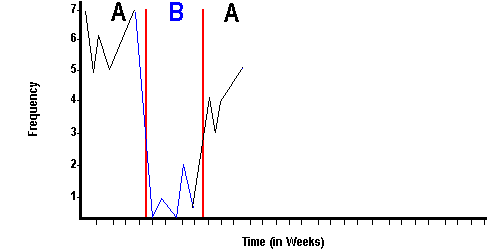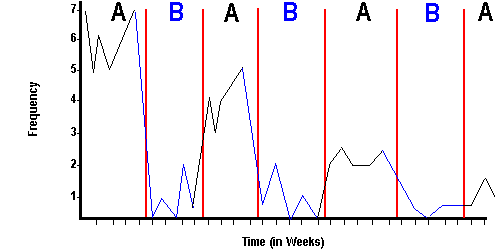CP 6691 - Week 7
Experimental Research Designs
(Single-Subject Designs)
Interactive Table of Contents (Click on any Block)
-
 Single-Subject Experiments Single-Subject Experiments
 The A-B Design Structure The A-B Design Structure
 Threats to Internal and External Validity of Single-Subject Experiments Threats to Internal and External Validity of Single-Subject Experiments
 Assignment for Week 8
Assignment for Week 8
Single-Subject Experiments
All of the research designs we've discussed up until now have involved many subjects (tens or even hundreds). But there are a host of research problems today that do not involve large numbers of subjects. In the fields of counseling and education, particularly, researcher have a need to answer questions that may affect only one or a few subjects. For example, in the classroom, a teacher wants to know what kind of intervention will work to correct a specific problem behavior from one of her students. Or, in the counseling field, a counselor is testing a new therapy involving four or five patients relating to post traumatic shock syndrome. Or, in behavioral psychology, a scientist is working with a child to try to reduce or eliminate his bed wetting behavior. Since these studies usually deal with one, or just a very few subjects, these experimental designs are called single-subject designs.
None of these studies are interested in generalizing results to a large population. Those conducting these studies are only interested in finding an immediate solution for the subjects at hand. Since generalizing is not a concern, there is no need to randomly select subjects for the study. Furthermore, with so few subjects, it is impossible to form discrete experimental and control groups as we saw in the research studies from last week. However, we can still evaluate them in terms of the internal and external validity threats we learned about last week.
Single-subject designs are somewhat of a misnomer, since it can refer to designs where one or more than one subject is being tracked. These designs are also capable of tracking single behaviors of subjects or multiple behaviors (next week's lesson). But, no matter whether the design is set up to track one subject or several subjects, one behavior, or several behaviors, the form of the design remains the same. It is called the A-B design structure.
The A-B Design Structure
Imagine for a moment you are a famous psychologist who has worked wonders with behavior modification techniques. One day a frantic mother comes to your office and asks if you can "cure" her 12-year-old son of his bed wetting problem. You tell her that there are no surefire cures ... that what works for one child may not work for another. But, you are willing to find the intervention that will work best for her son. In the past, you have had good success with electroshock therapy for bed wetting problems, so you plan to use that technique first. Now that you know what intervention you will use, what do you think is the first thing you need to do before treating the patient? Check your answer here, then continue.
Usually, the frequency of behaviors being treated are plotted on a graph with frequency on the Y-axis and time on the X-axis. The time axis is usually measured in increments that produce a broad variation on the frequency axis. For instance, in our bed wetting example, since it's unlikely that the child will wet the bed more than once a night, using a time increment of days would only allow for a variation on the Y (frequency) axis of zero or one. Instead, the time increment should be measured in weeks. This will allow for a variation on the Y-axis of from zero to seven bed wettings per increment. This is a more appropriate variation. So, the plotting graph would look something like the diagram below.

Next, you take some baseline measurements of the child's bed wetting activity for several weeks. This is the A portion of the design. Although human behavior is anything but stable, after a few weeks, you will get what appears to be a stable bed wetting pattern. Next, apply the treatment, and keep taking weekly measurements. This is the B portion of the design. This is shown in the diagram below:

You notice that the treatment has the desired effect, reducing the incidence of bed wetting. The proof of the treatment is whether or not it has any long-term effect. So, you remove the treatment and go back to a new baseline behavior pattern as shown in the diagram below. Notice, in the diagram, that the new baseline is lower than the original baseline, which is at least going in the right direction.

So far, what we have is nothing but a pretest - post test design (with no control group). But, what if this new baseline level is still not adequate for the mother? What if she wants her son's bed wetting reduced even more? The power of the single-subject design is its ability to replicate easily. This is called a reversal. In other words, you can continue to reapply the treatment and cycle back and forth between treatment and baseline until you get to a baseline condition that is acceptable to the mother. The diagram below gives an illustration:

Threats to Internal and External Validity of Single-Subject Experiments
- Internal Threats:
-
- History: A possible threat depending on whether you can identify an event external to the study that is beyond the researcher's control that can affect the dependent variable, and if the study is long enough for history to have an effect.
- Maturation: A possible threat depending on whether you can argue that the dependent variable can be affected by maturational effects, and depending on if the study is long enough for maturation to have an effect.
- Testing: If pencil-and-paper tests are being used as the measures, and if they are all the same test, and if the interval between tests is relatively short, then it is possible for subjects' performance on the tests to improve due to remembering (the testing effect).
- Instrumentation: Instrumentation takes on an additional character in single-subject studies, because so many measures are taken. If the measures used are tests, be alert to the possibility that subjects could become test-wise. If the measures are observations, be sensitive to the fact that inter-observer agreement should be consistent across all observations, especially if different observers are used at different times.
- Statistical Regression: Because single-subject studies do not deal with groups of subjects, there are no group means to suffer from possible regression effects. Single scores do not regress reliably. So, this is not a serious threat in these type of studies.
- Differential selection: Not an issue (since there is no control group, subjects are not assigned -- they all receive the treatment).
- Selection-maturation interaction: Not an issue because differential selection is not an issue.
- Experimental mortality: Always a potential problem. It is even more devastating in single-subject studies for obvious reasons.
Remember, that there is no control group or random assignment process to cancel out any of the internal threats.
- External Threats:
-
- Population Validity: Threats to population validity are not an issue in single-subject designs because subjects are not selected from a general population with the idea of generalizing results. Since only one or a very few subjects are used in such studies, we don't need to address the issue of random or nonrandom selection. Consequently, you must be very careful to whom we generalize results. Generalizations must be make by considering the subjects' demographic information provided by the researcher.
- Personological Variable Validity: A potential threat just as in other experimental studies.
- Ecological Validity: A potential threat just as in other experimental studies.
End of Week 7 Lesson
| Assignment For Next Week |
| Gall: Chapter 13 ("A-B" (Multiple-Baseline) Designs) |
| Due Next Week |
Prepare to give oral presentation
of your research proposal. |
|